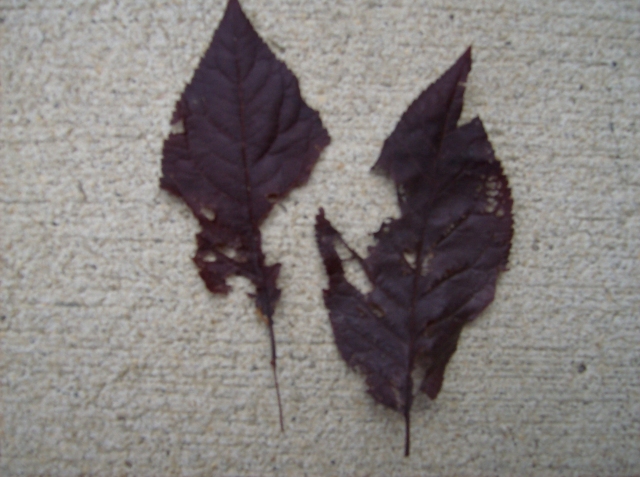Question
 Tree leaf
Tree leaf
this season the tree started out blooming very well,but it has just started to do the same thing as last year,the leaves are latterly being eaten away,and I do not see any bugs,not sure what to look for. Thank you in advance for any information
AnswerI would guess that this is the feeding of Japanese beetles. There are a few caterpillar type insect that feed on plum leaves but you should see the caterpillars. Sometimes the beetles are not present in the daytime--more active in early morning or at dusk.
Many insecticides are labeled for Japanese beetle control on landscape plants. Examples include acephate (Orthene Turf, Tree & Ornamental Insecticide), carbaryl (Sevin and many other brand names), cyfluthrin (Bayer Advanced Garden Multi-Insect Killer Concentrate), lambda-cyhalothrin (Spectracide?Triazicide?Soil & Turf Insect Killer Concentrate), esfenvalerate (Ortho Bug-B-Gon Garden & Landscape Insect Killer Concentrate), and permethrin (Spectracide?Bug Stop Multi-Purpose Insect Control Concentrate and many other brands). Neem extracts (Bon-Neem) deter Japanese beetle feeding but may not be adequate against high populations.
Direct spray applications of insecticidal soap kills Japanese beetles on contact but does not provide any residual protection.
Here are some points to keep in mind when using insecticides for beetle control -
Japanese beetle flight is greatest on clear days with temperatures between 84o and 95o F and winds less than 12 miles per hour. This can bring new beetles into your landscape to challenge any control program that you may have. When these conditions exist, check plants frequently to see if beetles are starting to feed again.
A few beetles on plants, or some moderate damage, will bring in more. Japanese beetles apparently produce aggregation pheromones that will attract more males and females to feed and find potential mates. In addition, volatile odors from damaged plants may attract more beetles. These conditions also can keep beetle numbers high. Keeping numbers and damage low can mean fewer new arrivals.
Japanese beetles begin to feed at the tops of plants and move down as defoliation occurs. This makes damage obvious, in terms of brown leaves and esthetic damage, but also can pose coverage problems on large trees. Hose end sprayers may allow applications to reach the target but spray drift and applicator exposure are potential problems.
Some of the effective insecticides for Japanese beetle control, such as carbaryl (Sevin) and the pyrethroids (permethrin and others) can contribute to build-ups of mites or aphids. Watch closely for signs of these pests and use acephate or malathion if needed. While these insecticides have a shorter residual life, they may help to reduce problems with secondary pests.
Repeated applications may be necessary because of the relatively short residual effect of the products. Also, a significant rainfall shortly after an application may reduce the insecticide deposit below effective levels.






